Are you tired of long recovery times after an intense workout?
You’re not alone!
Many athletes and fitness enthusiasts often struggle with slow muscle recovery, leaving them feeling fatigued, sore, and unable to perform at their best.
While there are many methods for workout recovery, one of the most powerful, and often overlooked, is the strategic use of breathing exercises for workout recovery.

In this complete guide, you’ll find my personal go-to breathing techniques for speeding up recovery, enhancing muscle repair, and reducing post-workout discomfort.
You’ll also discover some practical tools that I have found helpful in improving my recovery further.
Let’s get started!”
Understanding the Science of Workout Recovery
To truly understand the power of breathing exercises for workout recovery, it’s important to first delve into what happens inside our bodies after intense physical activity.
Proper recovery isn’t just about rest; it’s a complex process that involves several physiological mechanisms working together to repair, rebuild, and restore our bodies.
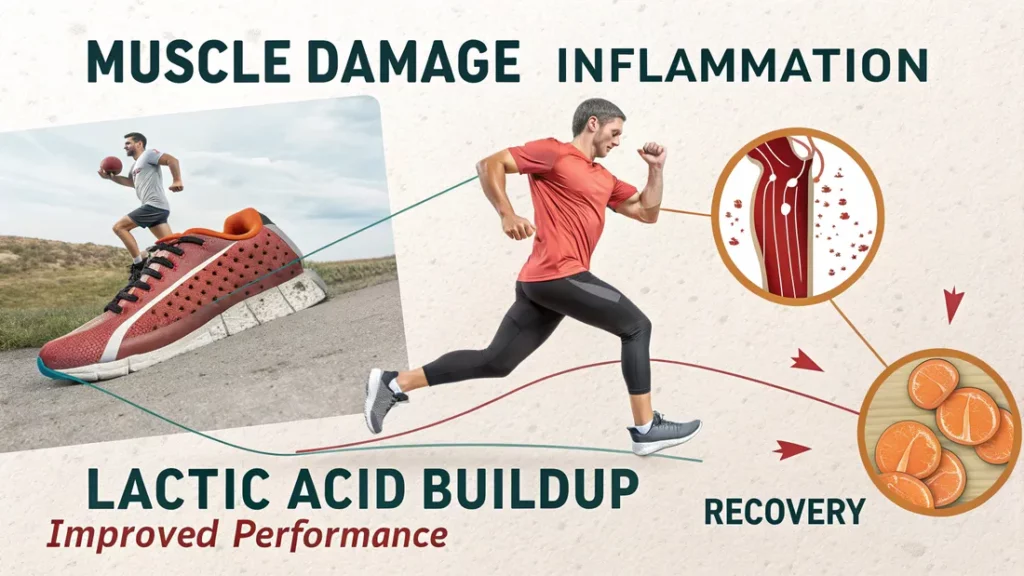
Why Proper Recovery is Essential
- Muscle Repair: Workouts cause microscopic tears in muscle fibers. Proper recovery is essential to allow muscles to repair, rebuild, and grow stronger.
- Muscle Soreness Reduction: Adequate recovery reduces muscle soreness and tension, allowing you to return to your workout routine faster.
- Reducing Tension: It is vital to reduce tension in the body so that it is in the best position to recover properly.
What Happens in Your Body After a Workout
- Lactic Acid Build-up: During intense exercise, lactic acid accumulates in the muscles, which can cause discomfort. Proper recovery is needed to clear it.
- Inflammation: Intense activity can cause inflammation in muscles and tissues. The body uses recovery to help reduce inflammation, and put the body back into balance.
- Muscle Damage: Microscopic tears in muscle fibers occur during a workout, which can cause discomfort. The process of repairing this is vital for improved performance in the future.
Impact of Poor Recovery
- DOMS (Delayed Onset Muscle Soreness): Inadequate recovery often leads to Delayed Onset Muscle Soreness, which can cause discomfort and restrict mobility.
- Overtraining: Not recovering enough can lead to overtraining syndrome, which can cause long-term problems such as injury, fatigue and burnout.
- Fatigue: Poor recovery results in lingering fatigue, which can reduce performance in the long-term.
How Breathing Techniques Speed Up Muscle Recovery
Now that we’ve explored the science behind workout recovery, let’s understand how breathing exercises can play a vital role in that process.
While it might seem counterintuitive, mindful breathing is a powerful method to help your body shift into recovery mode.
Let’s delve into how this works.

Breathing and the Parasympathetic Nervous System
- Deep, controlled breathing activates the parasympathetic nervous system, which is responsible for the ‘rest and digest’ response. This helps to reduce stress and promote relaxation.”
- This response counteracts the stress of a workout, shifting your body from a state of exertion to a state of calm. When activated, this will allow your body to focus more on recovery and repair, rather than being in a ‘fight or flight’ mode.
Breathing Exercises and Inflammation Reduction
- Proper breathing, such as diaphragmatic breathing, can improve blood flow and oxygen delivery throughout the body.
- This improved circulation helps to reduce inflammation in muscles and tissues by bringing much-needed nutrients and oxygen, as well as removing waste products quicker.
Breathing Methods for Speeding Up Recovery
- Specific breathing techniques can help your body to more quickly remove metabolic byproducts, such as lactic acid, which accumulates in muscles during intense activity.
- This also aids in muscle repair by helping oxygen reach the damaged cells and promoting overall muscle soreness reduction.
Addressing Skepticism
While the benefits of breathing for recovery might sound too good to be true, there is growing scientific evidence to support these claims.
Studies have shown that deep, controlled breathing can indeed reduce heart rate, blood pressure, and stress hormones, all of which can contribute to a faster recovery.
I always recommend doing your own research using trusted sources, or trying out the method for yourself.
You may be surprised with how you feel after implementing these methods!
My Go-To Breathing Techniques for Faster Recovery
Now that we have explored the importance of recovery and why breathing exercises can help, let’s delve into the specific techniques I personally use.
These are the breathing exercises that I have found the most effective in speeding up my recovery process, and I am excited to share them with you.
My Favorite Breathing Techniques for Workout Recovery (Table)
| Technique | How To Perform | Benefits for Recovery | My Experience |
| Diaphragmatic Breathing | Lie down or sit, place hands on chest and belly, inhale slowly (belly rises), hold briefly, exhale slowly (belly falls). | Maximizes oxygen intake, promotes relaxation, aids in muscle repair and reduces soreness, provides a state of mindful relaxation. | I use this as part of my cool down routine, and I feel significantly less sore when I do. |
| Paced Breathing | Find a comfortable position, inhale for a count of 4, exhale for a count of 4. Continue for 5 to 10 minutes. | Calms mind, reduces stress, helps to reduce muscle tension, promotes relaxation, helps with body synchronization. | I use this when I feel stressed and tense, and find that it helps to calm me down immediately. |
| Progressive Relaxation Breathing | Lie down or sit, and tense and release your muscles from your toes to your head as you perform deep breaths. | Promotes deep relaxation, reduces mental fatigue, enhances natural healing, improves focus on the present moment. | I use this to help me unwind after a long day and to prepare me for sleep. |
Diaphragmatic Breathing for Muscle Recovery
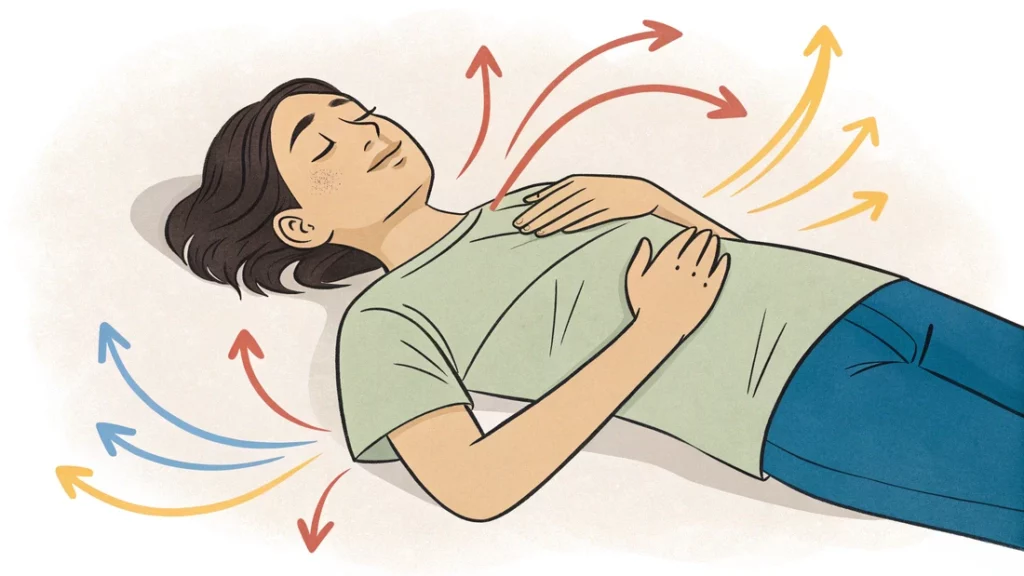
Diaphragmatic breathing, often referred to as belly breathing, is a method that focuses on engaging your diaphragm, which is the muscle at the base of your lungs, rather than shallow chest breathing.
This helps to maximize oxygen intake and promote relaxation, which is ideal for post-workout recovery.
- How to perform diaphragmatic breathing:
- Lie on your back or sit in a comfortable position.
- Place one hand on your chest and the other on your belly.
- Inhale slowly through your nose, allowing your belly to rise while keeping your chest relatively still.
- Hold your breath for a couple of seconds.
- Exhale slowly through your mouth, allowing your belly to fall.
- Repeat this method for 5 to 10 minutes.
- How Diaphragmatic Breathing Helps With Recovery:
- By maximizing oxygen intake, this technique assists in muscle repair and reduces muscle soreness. The process also allows you to enter a state of mindful relaxation, which promotes overall well-being.
- My Personal Experience:
- I have integrated this technique into my daily routine, and have found it to be particularly effective in reducing tension and soreness. I often practice diaphragmatic breathing as part of my cool down routine, which has drastically improved how I feel the next day.
Paced Breathing for Tension Release
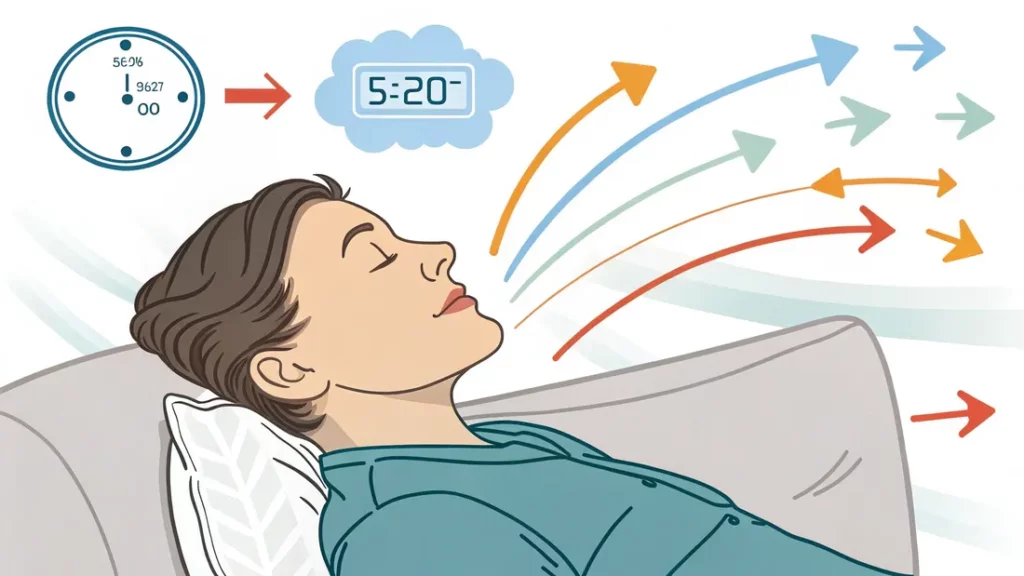
Paced breathing, also called rhythmic breathing, involves coordinating your breath with a specific count or rhythm.
This technique helps to calm the mind and reduce tension by synchronizing your body.
- How to perform paced breathing:
- Find a comfortable position, and close your eyes.
- Inhale through your nose for a count of 4.
- Exhale through your mouth for a count of 4.
- Repeat this breathing pattern for around 5 to 10 minutes, or until your body feels relaxed and calm.
- How Paced Breathing Helps With Recovery:
- This rhythmic breathing pattern helps to reduce stress hormones, which in turn reduces muscle tension and promotes overall calmness.
- My Personal Experience:
- I have found that when I use paced breathing after my workouts, it helps me to unwind, and also reduces the overall tension I may have been holding onto.”
Progressive Relaxation Breathing for Mental Calm

Progressive relaxation breathing combines deep breathing with a progressive tensing and releasing of muscle groups.
This helps to promote deep relaxation, which will help to reduce mental fatigue and allow your body and mind to unwind effectively.
How to perform progressive relaxation breathing:
- Find a comfortable position.
- Inhale deeply and tense your toes for a couple of seconds.
- Exhale slowly and release all the tension from your toes.
- Continue this tensing and releasing process from your toes to your head. Tense the area as you inhale, and release it on the exhale. Be sure to focus on each area as you move upwards.
- Continue this breathing method for 5 to 10 minutes until you are in a state of calm.
How Progressive Relaxation Breathing Helps With Recovery:
- This method helps reduce mental fatigue and promote relaxation which enhances the body’s natural healing processes.
- The mindfulness that is needed also helps you to focus on your breath, and unwind from the stresses of the day.
My Personal Experience:
- I have been using progressive relaxation breathing for around 15 minutes before I go to sleep.
- This helps me to unwind from the stresses of the day and allows me to feel calm and relaxed before I go to sleep.
Tools To Enhance Your Breathing Recovery
While breathing techniques themselves are a powerful and accessible way to promote faster recovery, there are several tools that can further enhance the benefits.
These are products that I have personally used and that have helped me to better my recovery experience.
They can help with muscle tension, promote relaxation, and enhance your breathing techniques.
Foam Roller for Muscle Tension Relief
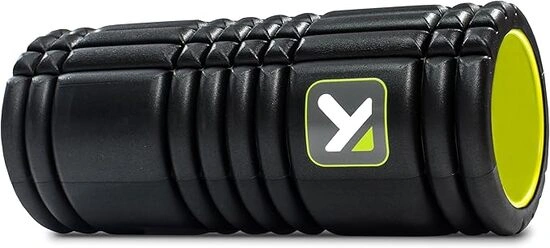
A foam roller is a cylindrical tool used for self-myofascial release, which is essentially self-massage.
It helps to reduce muscle tension and improve blood flow, which is essential for muscle recovery.
- How it aids recovery:
- By using a foam roller, you can release any tension that has accumulated in your muscles, which helps with your overall recovery process, and makes it easier for your body to perform its natural function.
- How it can be used with breathing techniques:
- You can use a foam roller in conjunction with your breathing exercises. I always use my foam roller while performing paced breathing. I’ve found that when I release the tension in my muscles using a foam roller while using my breathing techniques, I feel even more relaxed and at peace.
- My Personal Experience:
- I have been using a foam roller for years, and have always found it a great way to help improve my overall muscle tension and reduce muscle soreness. It has been a game changer for my recovery. I tend to focus on my legs and back, which often get quite tense when I workout.”
- Amazon Affiliate Link:
View this Foam Roller on Amazon.
Essential Oil Diffuser for Relaxation
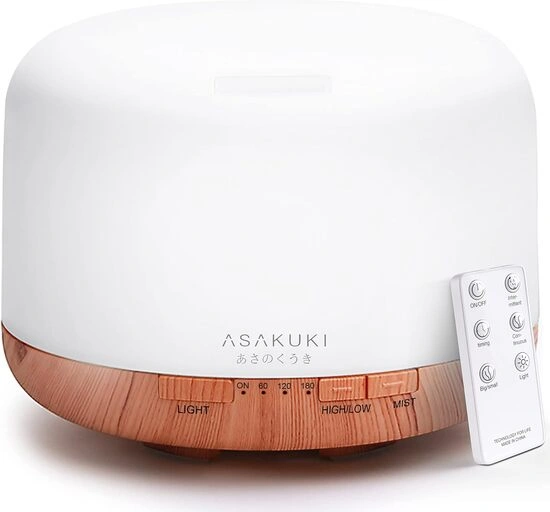
An essential oil diffuser is a device that disperses essential oils into the air, which are known for their therapeutic properties.
Many essential oils are known to promote relaxation and reduce stress, which can be very helpful for recovery.
- How it aids recovery:
- By inhaling calming essential oils, such as lavender or chamomile, you can enter a state of relaxation that will promote better rest and recovery, while also reducing stress hormones in the body.
- How it can be used with breathing techniques:
- An essential oil diffuser is ideal for using when doing techniques such as diaphragmatic or progressive relaxation breathing. I find that the aroma of the oils helps to enhance my relaxation practices, and calms my mind.
- My Personal Experience:
- I personally enjoy using a diffuser with lavender essential oil as part of my recovery routine. I turn it on when I perform progressive relaxation breathing, which helps me to feel more relaxed and at ease.”
- Amazon Affiliate Link:
View an Essential Oil Diffuser on Amazon.
Weighted Blanket for Calming Nerves
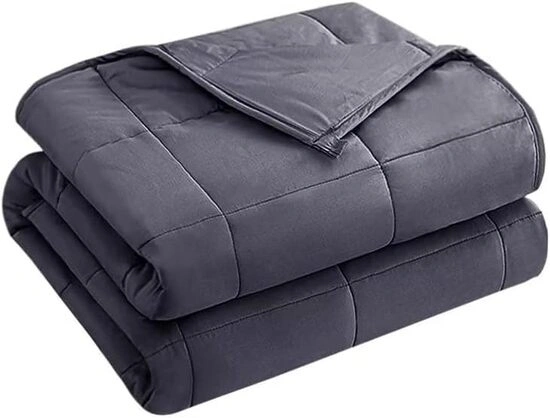
A weighted blanket is a blanket that has added weight to provide deep touch pressure, which can reduce anxiety and calm your nervous system.
This is ideal for when you are trying to unwind and focus on your breathing.
- How it aids recovery:
- The deep touch pressure from a weighted blanket helps to lower the stress hormone cortisol, which will in turn promote a greater feeling of calm, making it ideal for recovery, as it will allow your body to rest and recover in a state of calm.
- How it can be used with breathing techniques:
- I like to use my weighted blanket during my paced breathing exercises. I find that the pressure soothes my nerves, and helps me to connect more with my breath.
- My Personal Experience:
- I use my weighted blanket every night, and have been blown away by how relaxed I feel with it. It’s something that I use even when I am not doing my recovery exercises, as it makes me feel safe and comfortable.”
- Amazon Affiliate Link:
View this Weighted Blanket on Amazon.
Practical Tips for Improving Your Breathing Recovery
Now that you’re equipped with knowledge about the science and techniques of breathing for recovery, let’s explore some practical tips to help you integrate these practices into your daily life effectively.
It’s not about making drastic changes; it’s about making sustainable choices that will support your journey towards a better recovery.
Key Points
- Consistency:
- Make sure you are consistent with your practice. Doing a little bit each day is far more effective than trying to cram in a lot of practice every now and again. Consistency is key to reaping the benefits of these methods.
- Integration:
- Incorporate these methods into your daily routine. Whether you choose to focus on your breathing after your workout, before bed, or during any breaks, find a routine that fits with your lifestyle. Making it a part of your daily routine will ensure that you are reaping all of the benefits from your breathing exercises.
- Mindfulness:
- Be mindful as you perform these exercises. Focus on your breath, your body and how you feel as you use each of these methods. Try to reduce any outside distractions so that you can be fully immersed in your practice.
- Listen to Your Body:
- Remember to always listen to your body and pay attention to how you are feeling. If you are feeling any discomfort or pain, immediately stop what you are doing and take a break. Be patient with yourself, and ensure that these methods are working for you.
- Set Achievable Goals:
- Set yourself goals that are both achievable and attainable. Instead of setting a goal of doing these methods for an hour a day, perhaps start with 5 minutes and slowly increase the time as you see fit. These methods are meant to be part of your life, so you should focus on implementing them in a sustainable way, which is different for everyone.
Frequently Asked Questions About Breathing for Workout Recovery
To provide you with the most comprehensive understanding of breathing for workout recovery, I have compiled a list of frequently asked questions.
These questions come directly from what people are asking online, and I will attempt to answer them to provide you with as much value as possible.
- Question 1: How long should you do breathing exercises after a workout?
- Answer: The duration of breathing exercises can vary depending on your individual needs and preferences. However, I have found that spending at least 5 to 10 minutes on breathing exercises immediately after a workout can provide significant benefits. If you can manage it, aim for 10 to 15 minutes for optimal results, and to allow your mind and body to unwind. You can also integrate breathing exercises into your daily routine, rather than simply after your workouts.
- Question 2: Can deep breathing help with DOMS?
- Answer: Yes, deep breathing can help alleviate DOMS (Delayed Onset Muscle Soreness). The practice helps to reduce stress hormones, while also increasing blood flow which assists in muscle repair and waste removal. Both of these are key to reducing DOMS. I highly recommend implementing diaphragmatic breathing into your recovery routine to alleviate discomfort.
- Question 3: How does breathing speed up muscle recovery?
- Answer: Breathing exercises help to speed up muscle recovery by activating the parasympathetic nervous system (also known as the rest and digest system) which is responsible for reducing stress hormones and improving your state of relaxation. Breathing also improves oxygen flow which is essential for muscle repair and removing waste products from the muscles, which helps to reduce muscle soreness. It is a crucial part of the recovery process, as it helps your body to perform its natural functions more efficiently.
- Question 4: What are the best breathing patterns for recovery?
- Answer: I have found that diaphragmatic breathing, paced breathing and progressive relaxation breathing are some of the best breathing patterns for workout recovery. These techniques help to improve oxygen flow, reduce stress and muscle tension, which helps to bring your body into a state of calm, and aids in recovery. They are effective and easy to implement for any individual who is seeking to improve their recovery routine.
- Question 5: Are breathing exercises enough for muscle recovery?
- Answer: Although breathing is a very powerful method for improving recovery, it is not the only method that should be used. Breathing can be combined with other recovery methods such as foam rolling, stretching, or using recovery tools. You may also find that implementing lifestyle changes such as good sleep and proper hydration can also contribute to a better recovery experience. The best approach is to use a combination of all methods for the most effective results.
My Final Thoughts On Breathing For Faster Recovery
As we reach the end of this comprehensive guide, I hope you are now more aware of the powerful impact that breathing exercises can have on your workout recovery.
Here are my final thoughts:
Key Points
- The Power of Breathing: Recognize the powerful impact that breathing exercises can have on workout recovery.
- Comprehensive Exploration: We’ve explored the science of recovery, the importance of breathing, and specific techniques.
- Essential Recovery: Remember that recovery is just as important as your workout, and should be treated with the same dedication.
- Benefits of Prioritization: Prioritize your breathing to speed up muscle repair, reduce tension and soreness, and promote calmness.
- Implement Key Techniques: Start implementing techniques like diaphragmatic breathing, paced breathing, and progressive relaxation into your routine.
- Explore Helpful Tools: Consider using tools like foam rollers, essential oil diffusers, or weighted blankets to further enhance your practice.
- Make it a Lifestyle: Incorporate these methods into your daily routine to make it a long-term change, rather than a temporary fix.
- Consistency: The key is consistency, so make sure to practice regularly.
- Personal Transformation: These methods have transformed my own recovery process, and I believe they can do the same for you!
- Positive Outcomes: I wish you all the best on your recovery journey, and I hope that you see positive results!
- Call to Action: Go forth and breathe!
Citation
The Effect of Diaphragmatic Breathing on Attention, Negative Affect and Stress in Healthy Adults – National Institutes of Health (NIH) (.gov)
Diaphragmatic breathing exercises in recovery from fatigue-induced changes in spinal mobility and postural stability: a study protocol – National Institutes of Health (NIH) (.gov)



